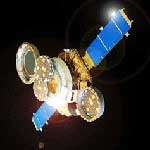What Genesis Solar Particles Can Tell Us

The recent crash of NASA's Genesis space probe may have looked like bad news for scientists, but its cargo of particles captured from the sun should still yield useful information, according to Qing-Zhu Yin, a planetary scientist at UC Davis.
Yin, who is not directly affiliated with the Genesis mission, studies the composition of meteorites to learn about the formation of the solar system. Like the Genesis capsule, meteorites have a hard landing on the Earth, but can still yield useful information, he said.
By looking at the ratio of oxygen-16, -17 and -18 isotopes in the solar particles, scientists should be able to test theories about how the sun and planets formed. Oxygen-16 is by far the most common. The Earth, moon, Mars and some meteorites all have slightly different ratios of the three isotopes.
The oxygen makeup of the sun, which contains about 99.9 percent of all the mass in the solar system, is much harder to measure. The Genesis spacecraft was built to answer that question by collecting particles blown out from the sun.
In a "Perspectives" article in the Sept. 17 issue of the journal Science, Yin describes new theories about local variations in oxygen isotopes in the vast dust and gas cloud around the young sun. Free oxygen was released when ultraviolet light hit carbon monoxide gas. Because oxygen-16 was so abundant, it was released mostly near the surface of the cloud, but breakdown of carbon monoxide containing less abundant oxygen-17 or -18 continued deeper into the cloud.
Free oxygen and hydrogen formed water that froze onto dust grains and eventually formed into planets, preserving the oxygen-17 and -18 signature, Yin said. The models predict that the Sun itself should have a much lower ratio of oxygen-17 and -18 to oxygen-16 than the rocky planets, a prediction that can be tested by Genesis and future missions.
Source: UC Devis


















